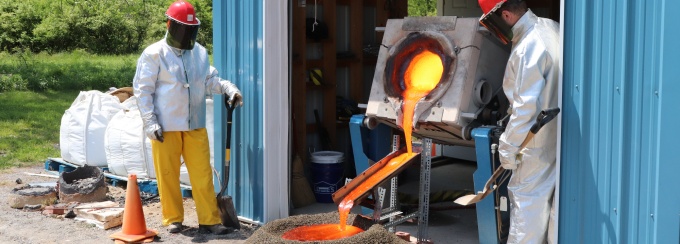Geohazards Field Station

The Geohazards Field Station is a location dedicated to large-scale (“too large for a lab”) experimentation of hazardous processes. It is a multi-purpose collaborative user facility that is in current use and also experiences ongoing development to broaden the experimental capabilities in the near future. The Field Stations is supported by University at Buffalo’s extreme events long term strategic strengths effort. It’s heart is a piece of land, located about 50 miles (80 km) South of Buffalo, which provides 700 acres prepared, experimentally usable area.
The Field Station provides the fundamental infrastructure and expertise for
experimental large-scale projects. An on-site multi-purpose building supplies electricity and gas, provides equipment and office space as well as basic machining capabilities. Established connections to suppliers of the necessary large material volumes (e.g. gravel material), to contractors for ground motion and to community mitigators ensure the site’s good workflow. The constantly growing equipment pool currently features a microphone set (20 kHz), a diverse imaging pool: still image cameras, embedded and high-quality standard speed (HD and 4k) cameras, and several high-speed imaging systems (practical frame rates up to 5000 fps), Geophones, wide-frequency range ground pressure sensors, and free air blast sensors. A data acquisition system, and a robust, low-latency synchronization system provides a central common high-precision time line for sensors and cameras. A rock melting facility with application focus on volcanic processes as e.g. melt-water interaction is currently under construction (see below).
Excellent opportunities for student training is a natural consequence of the Field Stations motivational focus on hazardous processes, and it’s interdisciplinary architecture. As the experimental scale places the Field Station between Geosciences, Engineering and Physics, the wide scientific interfaces provide opportunities in many different flavors, reaching from practical, hands-on training to complex experimental conceptual design and theoretical modeling.
Examination of Volcanic Subsurface Explosions With Multi-blast Cratering Experiments

Volcanic craters are typically formed by multiple subsurface explosions that can occur at slightly or strongly varying horizontal and vertical locations, in strongly varying heterogeneous environments. The project aims to experimentally investigate key questions concerning volcano specific surface and subsurface processes as e.g. effects of pre-existing craters on the blast jet and ejected material, explosion energy- and vertical location, pulsatory subsurface material transport, and effects due to lateral explosion migration. The experiments are pragmatically grouped to sessions that focus on specific questions (e.g. lateral explosion migration).
Four experiment sessions were conducted. The fifth is in preparation.
- 2012 – focus: multiple blasts, crater sizes
- 2013 spring – focus: subsurface material transport, vertical explosion migration (deep)
- 2013 fall – focus: surface morphology, vertical explosion migration (shallow)
- 2014 – focus: horizontal explosion migration, atmospheric and ground shock
4 sessions done, 5th session in prep., NSF funded project
Rock Melting Facility for Melt-water Interaction
We are building a rock melting facility for experiments with a strong focus on all types of melt-water interaction. The first application will investigate the explosive interaction of molten volcanic melt and water (see below). The facility consists of a melting furnace, which is capable to heat rock samples up to 1400 ºC, and is currently under construction. The furnace is located in “free air” at the field station, where safety measures are taken to meet fire and shock wave hazards adequately. Once construction has finalized the facility, the equipment, supplies and experimental expertise, will be open to all interested researchers.
Explosive Interaction of Volcanic Melts and Water
This project will investigate the highly explosive molten fuel coolant interaction (MFCI) mechanism experimentally. This mechanism is thought to be responsible for the formation of maar-diatreme volcanoes, and parts of larger volcanic eruptions when water is locally available, as for example many eruptions of the ice-covered volcanoes in Iceland (e.g. Eyjafjallajökull, Grímsvötn). Experimentally the project relies on the field station’s rock melting facility. 25–30 L of molten volcanic rock will be poured into an insulated container. There (liquid) water will be injected into the melt and brought to explosion. The setup enables the investigation of questions regarding the melt-water premix, start and trigger of the explosion, and the scaling of the overall process.
Status: under construction, NSF funded project